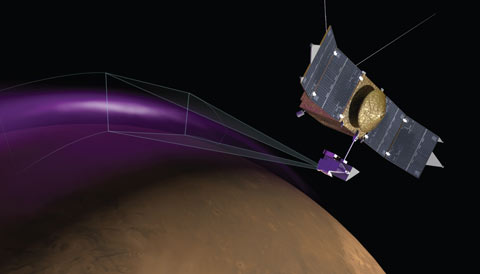By: Camille M. Carlisle | March 24, 2015
NASA’s MAVEN spacecraft has detected dust high in Mars’s atmosphere and auroras across the planet’s northern hemisphere.
The bat-winged MAVEN spacecraft has now been in orbit for six months, dipping in and out of the Red Planet’s atmosphere in a looping orbit that slowly shifts around the planet. It’s investigating what goes on in Mars’s atmosphere and how the planet loses atmosphere over time.
This artist’s conception shows MAVEN’s Imaging Ultraviolet Spectrograph (IUVS) observing the “Christmas Lights Aurora” (purple) on Mars. The aurora persisted for five days and were detected at ultraviolet wavelengths.
University of Colorado
As part of that investigation, it’s now found two intriguing features high above the planet’s surface: dust and auroras.
MAVEN found the dust indirectly, by what grains do to the spacecraft when they hit it, explains mission principal investigator Bruce Jakosky (University of Colorado Boulder). When a speedy dust mote hits hard enough to vaporize and ionize its bits, the aftermath affects the spacecraft’s electrical potential and creates a milliseconds-long signature that the Langmuir Probe and Waves (LPW) instrument can detect.
The spacecraft has now completed more than 800 orbits around Mars, and the team has detected these dust impacts ever since turning on the instrument. But they don’t see the dust everywhere: MAVEN’s orbit precesses around Mars, meaning that over time the spacecraft’s closest point to the surface moves around the planet. LPW detected dust near local dawn and dusk, but not at night. “That’s an important clue, but we haven’t yet figured out how to interpret it,” Jakosky says.
The dust also seems unconnected to the surface features below. That’s unsurprising, Jakosky says, given that the dust is generally concentrated between 150 and 500 kilometers (90 and 300 miles) above the surface — it also occasionally shows up as high as 1,000 km — and it’s hard to imagine how something on the surface could affect things that high up.
The detection is curious, coming after a recent study reporting a transitory, dusty plume on Mars’s dawn limb. Image analysis by that team also suggested an altitude of a couple hundred kilometers, although others think the plume is likely much lower. But Jakosky cautions that we simply don’t know enough about either detection to know whether there’s a connection. The limb plume also only lasted for about a month, whereas MAVEN has detected its dust for six months.
It’s hard to explain how dust would get to this part of the atmosphere, Jakosky says. Raising it up from far below doesn’t make sense, physics-wise. Off-planet alternatives include dust from Mars’s two moons, Phobos and Deimos, or dust carried by the solar wind. It might also be comet debris the planet picks up along its orbit, although it doesn’t seem to be related to Comet Siding Spring, which brushed past Mars in October. But none of these alternatives is a shoo-in.

